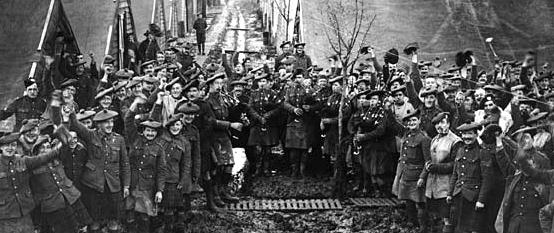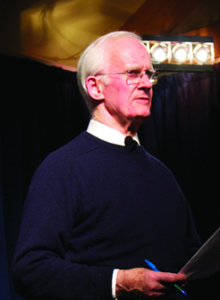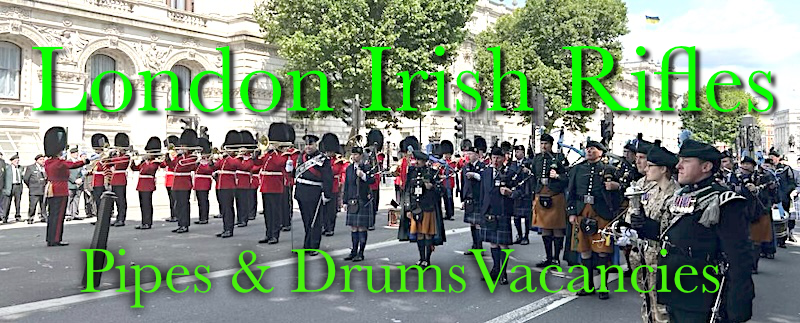 The Scottish Pipers’ Association series of pipe music from World War 1 has thrown up some interesting information and also given an airing to otherwise little heard pieces. The concert on July 30th this year continued this worthwhile endeavour. The performers were Dr Angus MacDonald and Douglas Murray with the well-researched lecture given by respected military historian and author, Colin Campbell (below). He began with background to some of the regiments – Scottish and overseas – involved in the conflict.
The Scottish Pipers’ Association series of pipe music from World War 1 has thrown up some interesting information and also given an airing to otherwise little heard pieces. The concert on July 30th this year continued this worthwhile endeavour. The performers were Dr Angus MacDonald and Douglas Murray with the well-researched lecture given by respected military historian and author, Colin Campbell (below). He began with background to some of the regiments – Scottish and overseas – involved in the conflict.
 The Cameronians: With the restoration of the Stuarts in 1660, there followed the enforcement of the ‘killing times’ when Presbyterian ministers who would not sign up to episcopacy [Covenanters] were forced to preach at hidden conventicles in the hills, often harassed by dragoons. Those who guarded them became known as Cameronians, after notable Covenanter Richard Cameron. They were formalised as a regiment in 1689, and fought and won their first battle at Dunkeld in the same year, defeating Montrose’s Jacobites. They subsequently fought with Marlborough in Flanders and in the Napoleonic Wars.
The Cameronians: With the restoration of the Stuarts in 1660, there followed the enforcement of the ‘killing times’ when Presbyterian ministers who would not sign up to episcopacy [Covenanters] were forced to preach at hidden conventicles in the hills, often harassed by dragoons. Those who guarded them became known as Cameronians, after notable Covenanter Richard Cameron. They were formalised as a regiment in 1689, and fought and won their first battle at Dunkeld in the same year, defeating Montrose’s Jacobites. They subsequently fought with Marlborough in Flanders and in the Napoleonic Wars.
In 1794 the 90th Perthshire Volunteers were founded by Thomas Graham. They were known as the ‘Perthshire Greybreeks’, became a light infantry unit, served in Crimea and the Indian Mutiny, and amalgamated with the Cameronians (Scottish Rifles) in 1881. Proud, and rather than face amalgamation with other Scottish regiments, the Cameronians disbanded in 1968. They wore the Douglas tartan, and this can still be seen worn by pipers of the Royal Gurkha Rifles and in the Witwatersrand Rifles in South Africa.
The Highland Light Infantry: Forerunners of the HLI were 71st and 74th Highland Regiments of Foot. The 71st was raised in 1777 and served in India, the Napoleonic Wars and the Indian Mutiny. The 74th were raised in 1787 and fought in the Peninsular War 1810 – 1812. Their Piper McLaughlin led the storming of Badajoz until his bag was punctured by a bullet, and at Vittoria he was shot in both legs but played on until he died. Both regiments wore the kilt. When the 71st became light infantry, they wore trews, and the 74th abandoned the kilt in favour of trews on service in India. The HLI amalgamated with the Royal Scots Fusiliers in 1959 to become the Royal Highland Fusiliers.
Overseas regiments, firstly Canada: Canadian Scottish (Princess Mary’s) Victoria, BC; Seaforth Highlanders of Canada, Vancouver; Calgary Highlanders; Queen’s Own Cameron Highlanders of Canada, Winnipeg; Lake Superior Scottish, Thunder Bay; RHF of Canada, Cambridge, Ont.; Essex/Kent Scottish, Windsor, Ont.; Argyll & Sutherland Highlanders of Canada, Hamilton, Ont.; 48th Highlanders of Canada, Toronto; The Lorne Scots (Peel, Dufferin and Halton) Regiment, Brampton, Oakville, Georgetown; Toronto Scottish; Stormont, Dundas and Glengarry Highlanders, Cornwall; Cameron Highlanders of Canada, Ottawa; Black Watch of Canada, Montreal; West Nova Scotia Regiment, Kentville; 1st Btn. North Nova Scotia Regiment, Pictou; Cape Breton Highlanders, Sydney.
South Africa: Transvaal Scottish; Witwatersrand Rifles; Cape Town Highlanders.
Australia: 5/6th Royal Victorian Regiment; 10/27th Royal South Australian Regiment; 25/49th Royal Queensland Regiment; 31/42 Royal Queensland Regiment (Black Watch); 16th Royal West Australian Regiment.
New Zealand: Queen Alexandra’s Mounted Rifles (NZ Scots Squadron).
India & Pakistan: Major contribution to the war on the Western Front, Palestine and Mesopotamia.[easyrotator]erc_14_1414056032[/easyrotator]Tunes played by Douglas Murray included:
5th Cameronians Welcome Home by T Pollock. From November 15th the Cameronians fought through every significant campaign on the Western Front. Story told by one of their number of how they used to try to protect their bread by suspending it from a string on the trench dugout roof. They woke to find a rat swinging on the loaf as it ate it.
Rugby House by JD Cameron. Best guess is that this was a British objective in the Passchendaele area in 1917. Other code names used were Stirling Castle, Ascot Cottage, Francois Farm, MacDonald’s Woods and Malta House.
Sandy Strafed the Germans, in Logan’s collection by Percy W Scott. ‘Gott strafe England’ (May God punish England) was a German saying from the war.
Baron Bing of Vimy by P/M Lachlan Collie. Collie emigrated to Canada in 1882, to Winnipeg, and was pipe major to the Queen’s Own Cameron Highlanders of Canada, headquartered there. Born in 1858, he lied about his age so that he could serve in the Canadian Expeditionary Force (CEF). Baron Bing was the British Lieutenant General who commanded the Canadian and British assault on Vimy Ridge in 1917. The Canadian corps took the ridge, allowing it to dominate the plain of Douai. There were eight British divisions on their right, all part of the same battle, and the ninth Scottish, including the South African Brigade, made the furthest advance, 3.5 miles.
Captain Rae’s March or the 72nd Highlanders Farewell to Vancouver 1914 by P/M John Gillies. Capt. Rae commanded No.2 Company of the 16th Battalion CEF.
Muckin’ o’ Geordie’s Byre was played by P/M Gilbert MM at the Battle of Beaumont Hamel. P/M Gilbert received his Military Medal for piping his battalion into Leipzig Redoubt on July 1,1916, when they had 500 casualties. His unit was tasked with taking Munich Trench. The action was described: ‘When our barrage lifted and the first wave of our men attempted to go forward their dark forms showed up against the snow. They were met by machine gun fire, by rapid fire from the enemy trenches, and by snipers in skilfully chosen holes. Our bombardment had failed and it was impossible to get close quarters with the enemy….it represents to us the heroism of forlorn hope, the glory of unselfish sacrifice, the success of failure.‘ Three hundred killed or wounded.
7th HLI’s Farewell to Dunfermline by P/M William Ferguson. The regiment was billeted in Dunfermline and embarked on the Transylvania, at Devonport, on 26th May, 1915, arriving in Alexandria, Egypt, on June 5th.
An Eilan Ard, the High Island by P/M W Ferguson, 7th HLI. The P/M of the 6th HLI returned on leave with a new tune he had heard played on the piano and which he had taught his band. The band played it for Ferguson and he was asked, ‘What did you think of the tune Fergie?’ ‘Oh, it’s alright; I composed it!’
90th’s Farewell to France by P/M Iain MacPherson, 2nd Cameronians. The 90th Perthshire Volunteers amalgamated with the Cameronians in 1881.
Sad Am I also by P/M MacPherson, was written while he was in the trenches through most of the unpleasant battles on the Western Front.
Reel of Tulloch and Devil in the Kitchen were played by Canadian piper James Richardson when he got his Victoria Cross in 1916 at Regina Trench. Richardson piped as the men cut the barbed wire under fire and then led them through. He took his wounded Colour Sergeant Major back then returned to look for his pipes.
Tunes included in the recital by Dr Angus MacDonald:
Battle of Loos by P/M Alex Grieve, South African Scottish, DCM (won while acting as a runner in March 1918). This battle was designed to take pressure off the French who were bearing the brunt of the war. The battlefield was in the coal fields north of Lille in exposed and open countryside. In retaliation for the German use of gas, the British deployed it for the first time. The battle was a disaster for Scotland, as a disproportionately high percentage of the attacking troops were Scottish. The 15th Scottish Division made most progress until it ran out of leaders and steam. Casualties: 10th HLI 648 men, 12th HLI 553 men, 10th Scottish Rifles 485 men. Why should a South African write this tune? The SA brigade joined the 9th Scottish Division to fill the gap (losses) from the battle.
48th Highlanders of Canada by Angus J MacDowell. The composer was the son of Lt. Col. Thain W MacDowell VC DSO, 38th Ottawa CEF. The 48th were a militia regiment which volunteered for the 15th Btn. CEF. They fought in all the major battles on the Western Front and are now Canadian Forces Primary Reserve based at Moss Park Armoury, Toronto.
Lewis F Beaton by P/M William Ferguson. Beaton served in Gallipoli and in Palestine under P/M Ferguson and became P/M of the 7th Cameronians. After the war he co-founded the Scottish Piping Society of London and worked as a dentist in Twickenham.
The Highland Gathering at Tinques by W Buchanan. This was largely a homespun affair sustained by Scottish and Canadian troops and held on July 6th, 1918. Tinques is north-west of Arras. The official history reads: ‘The following Saturday, 6th July, the 3rd Brigade, which had three Highland battalions, acted as hosts to a Highland Gathering at Tinques….All Highland battalions of the Canadian Corps were represented as were most of the battalions of the 15th (Scottish) and 52nd (Lowland) Divisions. A day of competition … was climaxed by the playing of ‘retreat’ by the massed bands of the 3rd Brigade and the visiting units – the marching of 284 pipers and 164 drummers providing a soul-stirring spectacle.’
An Eala Bhan, The White Swan, was written on the Somme by a native of North Uist, Donald MacDonald of Corunna [sic], for a sweetheart he never married.
2nd Tynside Scottish March to the Somme by P/M Munro Strachan. Between 14th October and 17th November 1914, four battalions of the Tyneside Scottish were recruited, some 5,400 men. At the Battle of the Somme on July 1, 1916, as they walked in waves towards the enemy, they suffered 2,400 casualties; ten pipers killed, ten wounded.
Hills of Judea by P/M John MacKenzie, pipe major of the HLI 1915 – 1919. The 52nd Division and the Egyptian Expeditionary Force took the Judean Hills as part of the thrust to capture Jerusalem. In mid-November 1917 the 52nd took Nemi Samwil and El Jib, the high ground north-west of Jerusalem. When the city had fallen, the 52nd Division held the coastal sector of the front until it was relieved in March 1918, for transfer to France.
Major Manson at Clachantrushal by P/M Donald MacLean, P/M 2nd Seaforths and pipe major with the Canadians 1915 -17.
Festubert by P/M Sutherland, 1st HLI. This was a disastrous battle in May 1915 with one comment reading ‘ran into heavy machine gun fire from their left front; the location of the gunners was uncertain’.
Farewell to Cape Helles by P/M Willie Ferguson. Cape Helles was one of the two landing beaches at Gallipoli on 25th April, 1915. Of 200 men disembarking from the SS Clyde, which had been run aground to offload them, 21 reached the beach. The campaign was designed to put Turkey out of the war and open a route to Russia through the Black Sea. It bogged down immediately and, despite the sacrifices of the men, Gallipoli was evacuated by the 2nd December, 1915, without casualties.
Plains of Gaza/Bencorruma by P/M W Ferguson. There were three battles by the Egyptian Expeditionary Force [EEF] for Gaza, in April and May 1917, which it lost, and Gaza finally fell on 3rd of November 1917. The 52nd Division was not involved in the first battle of Gaza, but was involved in the second and third battles. The Australian Light Horse took Beersheba, to the east of Gaza in a cavalry charge.
Kantara to El Arish by P/M W Ferguson. Kantara is on the western edge of the Sinai Desert, 100 miles west of El Arish. The Turks had threatened the Suez Canal in late 1914 and 1915 and had been repulsed. The EEF composed of British, Australian, New Zealand and Indian troops began a cautious advance. Water, was a problem, as was supply in the desert, though each battalion had 70 transport camels. A railway, a road and a pipeline were constructed to facilitate the eastwards advance. The roads were simply several widths of wire mesh laid on desert sand, thus facilitating travel.
The next concert in the WW1 Pipe Music series is at the College of Piping on December 6 when Mr Campbell’s talk will be illustrated with music from Robert Wallace and Donald MacPhee.

















You mention that Donald MacLean (tune: Major Manson of Clachantrushal) was P/M of the 2nd Bn Seaforth Highlanders and pipe major with the Canadians 1915-1917. I thought that he was born in 1908 in Ballantrushal,Lewis and was P/M of the 2nd Bn Seaforth Highlanders 1936-1940. Is that a different Donald MacLean?